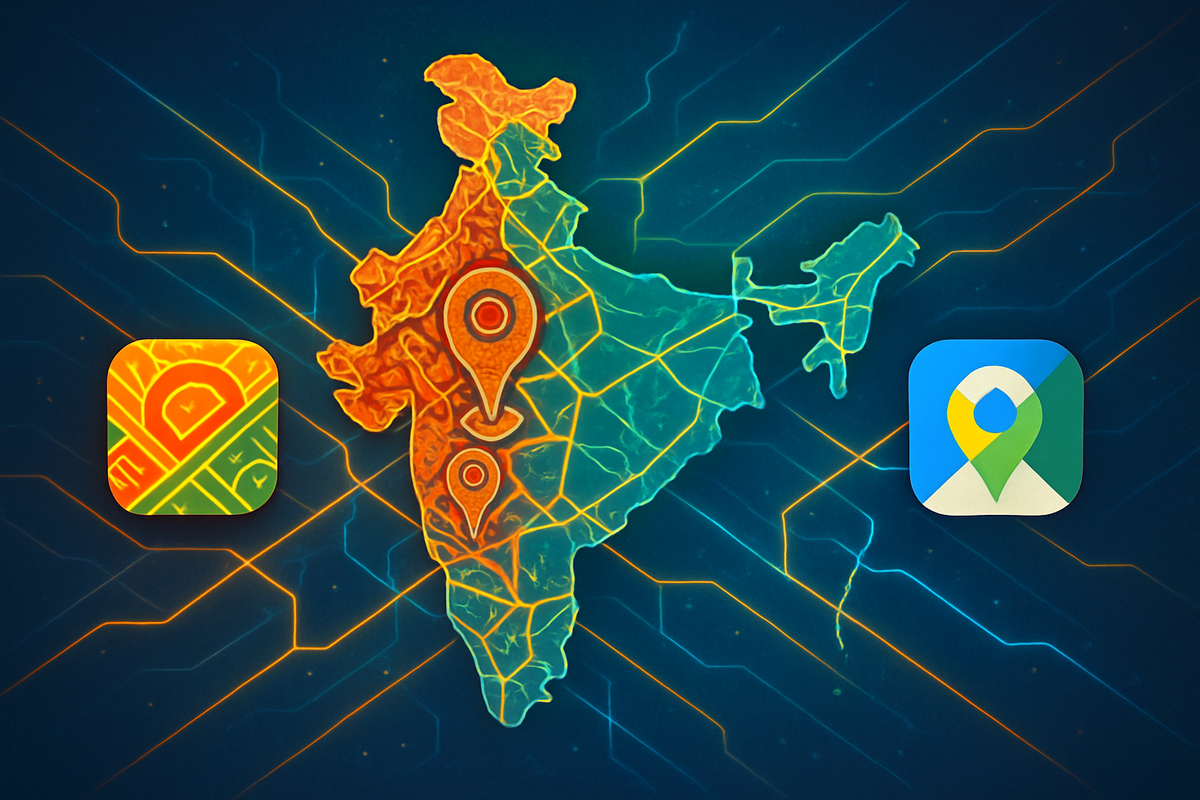
India's digital landscape is witnessing a significant shift in the navigation technology sector as Mappls, the consumer-facing app from veteran Indian geospatial company MapmyIndia (NSE: MAPMYINDIA), aggressively challenges the long-standing supremacy of Google Maps (NASDAQ: GOOGL). Leveraging a suite of hyper-localized features, a strong emphasis on data sovereignty, and robust government backing, Mappls is positioning itself as the "built for Bharat" alternative, potentially redrawing the competitive map for navigation services across the subcontinent and setting a precedent for indigenous tech innovation.
This burgeoning rivalry holds immediate implications for millions of Indian users and the broader technology market. Mappls' strategic focus on addressing India's unique geographical and infrastructural challenges – from complex addressing systems to intricate road networks – suggests a future where localized solutions could outperform global giants in specific markets. The unfolding competition promises to spur further innovation, enhance user experience, and underscore the growing importance of data privacy and national digital self-reliance in a rapidly evolving global tech arena.
The Road Ahead: Mappls' Strategic Ascent and Distinctive Features
Mappls' emergence as a formidable contender is not merely a tale of an underdog; it's a culmination of decades of deep-rooted mapping expertise by its parent company, MapmyIndia. Founded in 1995, MapmyIndia has been meticulously building India's digital map infrastructure long before international players entered the fray, supplying critical geospatial data to enterprise and government clients. The rebranding of its consumer app to Mappls in 2021 marked a deliberate pivot to directly engage end-users with a product tailored for the Indian context.
The app distinguishes itself through a range of innovative features designed to tackle India's unique navigation complexities. These include 3D Junction View, which offers realistic visuals of intricate intersections; Door-Level Navigation, providing precise guidance to specific building entrances; and Live Traffic Signal Timers in select cities like Bengaluru, offering real-time countdowns. Furthermore, Mappls' proprietary Mappls Pin & DIGIPIN system aims to revolutionize addressing with unique digital codes for every location, a crucial advancement in a country with often ambiguous addresses. Safety features like Speed & Traffic Monitoring Alerts for potholes, sharp turns, and accident-prone spots, coupled with extensive Regional Language Support across nine Indian languages, underscore its commitment to local relevance. Crucially, Mappls champions a privacy-centric approach, assuring users that their data remains securely within India's borders, a significant draw in an era of heightened data security concerns. This commitment, alongside collaborations with the Indian Space Research Organisation (ISRO) for enhanced satellite imagery, positions Mappls as a truly indigenous and technologically advanced solution. The public endorsement from Union Minister Ashwini Vaishnaw, which reportedly led to a tenfold increase in daily downloads, highlights the government's strategic intent to promote domestic technology under the "Aatmanirbhar Bharat" (self-reliant India) initiative, further cementing Mappls' position.
Navigating the Competitive Landscape: Potential Winners and Losers
The intensifying competition between Mappls and Google Maps is poised to create distinct winners and losers within the navigation technology sector and related industries. At the forefront of potential winners is MapmyIndia (NSE: MAPMYINDIA) itself, the parent company of Mappls. With its extensive, decades-long experience in mapping India, a robust enterprise client base, and now a rapidly growing consumer app, MapmyIndia stands to significantly expand its market share and revenue streams. Its emphasis on data sovereignty and hyperlocal accuracy aligns perfectly with government initiatives, potentially leading to deeper integration into public infrastructure projects and state-backed services. Increased user adoption of Mappls could also boost MapmyIndia's data analytics capabilities and its appeal to advertisers seeking granular location-based targeting within India.
Conversely, Alphabet Inc. (NASDAQ: GOOGL), the parent company of Google Maps, faces a formidable challenge to its long-held dominance in the Indian market. While Google Maps boasts a massive global user base and advanced features, its "one-size-fits-all" approach may struggle against Mappls' hyper-localized and India-specific innovations. Google may be compelled to invest significantly more in tailoring its services for the Indian market, accelerating feature development, and potentially adapting its data handling practices to address local privacy concerns. Failure to do so could result in a gradual erosion of its market share, particularly among users and enterprises prioritizing indigenous solutions or stricter data localization. Other smaller, regional navigation app developers might find it even harder to compete, squeezed between the global behemoth and a rapidly ascendant local champion. The automotive industry in India, which heavily relies on navigation systems, could also see a shift, with more OEMs potentially integrating Mappls or MapmyIndia's underlying mapping technology into their vehicles, impacting existing partnerships with global providers.
Broader Implications: Reshaping Industry Trends and Policy
The rise of Mappls transcends a mere market rivalry; it signifies a broader trend towards digital nationalism and localized innovation within the global technology landscape. This event perfectly encapsulates the "Aatmanirbhar Bharat" (self-reliant India) initiative, where the government actively promotes and supports indigenous technological solutions to reduce reliance on foreign platforms. This trend is not unique to India, with similar movements observed in other large economies seeking greater control over their digital infrastructure and data.
The potential ripple effects are significant. Competitors, both domestic and international, will likely be forced to re-evaluate their strategies for market penetration and product development in diverse regions. Global tech giants like Google may need to decentralize their development efforts, empower local teams, and foster more region-specific innovations rather than simply adapting global products. On the regulatory front, Mappls' emphasis on data sovereignty could set a precedent for stricter data localization laws and privacy regulations in India, potentially influencing how all tech companies operate within the country. This could lead to increased scrutiny on data storage, processing, and cross-border data flows, impacting compliance costs and operational models for international players. Historically, similar nationalistic pushes in sectors like telecommunications or software have often led to the emergence of strong domestic players, fostering local ecosystems but also sometimes creating barriers for foreign entities. Mappls' success could embolden other Indian tech companies to challenge global leaders in various digital domains, from social media to cloud services, further diversifying India's tech landscape.
What Comes Next: Strategic Pivots and Emerging Opportunities
In the short term, the navigation technology market in India is expected to witness intensified competition and rapid innovation. Both Mappls and Google Maps will likely accelerate their feature development, focusing on user feedback and regional nuances. Mappls will aim to solidify its user base through aggressive marketing, partnerships with device manufacturers, and deeper integration with government services. Google, in response, may roll out more India-specific features, enhance its existing offerings, and potentially engage in pricing strategies or partnerships to retain its users. The next few months will be crucial for Mappls to convert its initial momentum and government endorsement into sustained user growth and engagement.
Longer term, the success of Mappls could lead to several strategic pivots and emerging opportunities. For MapmyIndia, this could mean expanding its mapping expertise into other adjacent sectors like drone technology, smart city infrastructure, or autonomous vehicles, leveraging its high-accuracy geospatial data. The company might also explore international expansion into other developing markets with similar geographical complexities or data sovereignty concerns. For Google, the challenge from Mappls might necessitate a more decentralized approach to product development, potentially leading to the establishment of more independent regional innovation hubs. The broader market could see the emergence of specialized navigation services catering to niche segments, such as logistics, agriculture, or tourism, all built upon robust local mapping data. Regulatory frameworks around data privacy and digital infrastructure are also likely to evolve, creating new compliance challenges but also opportunities for companies that can navigate these landscapes effectively. The outcome will ultimately depend on user adoption, technological superiority, and the ability of both players to adapt to India's dynamic digital ecosystem.
Charting the Future: Key Takeaways and Investor Watchpoints
The rise of Mappls represents a pivotal moment in India's technology narrative, underscoring the growing capability of indigenous firms to challenge global giants with hyper-localized and privacy-centric solutions. The key takeaway is the increasing importance of "built for Bharat" strategies, where deep understanding of local nuances and adherence to national priorities like data sovereignty can be powerful differentiators. This competition will undoubtedly benefit Indian consumers with better, more tailored navigation services.
Moving forward, investors should closely watch several key indicators. For MapmyIndia (NSE: MAPMYINDIA), monitor user acquisition rates, engagement metrics, and the expansion of its enterprise and government partnerships. Any announcements regarding integration with critical public services or new feature rollouts will be significant. For Alphabet Inc. (NASDAQ: GOOGL), observe its strategic responses to the Mappls challenge in India, including investments in localized features, marketing campaigns, and any shifts in its data handling policies for the region. The broader implications for the Indian tech market include a potential surge in investments in local startups aligned with the "Aatmanirbhar Bharat" vision and a re-evaluation of market entry strategies by international players. The success of Mappls could serve as a blueprint for other Indian companies aiming to disrupt established markets, marking a new chapter for digital self-reliance and innovation in one of the world's largest digital economies.
This content is intended for informational purposes only and is not financial advice








